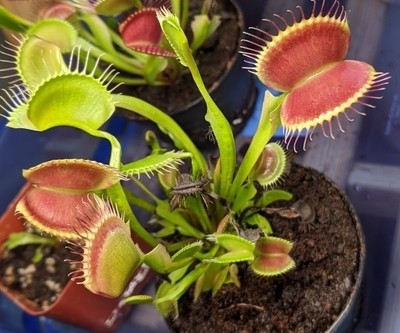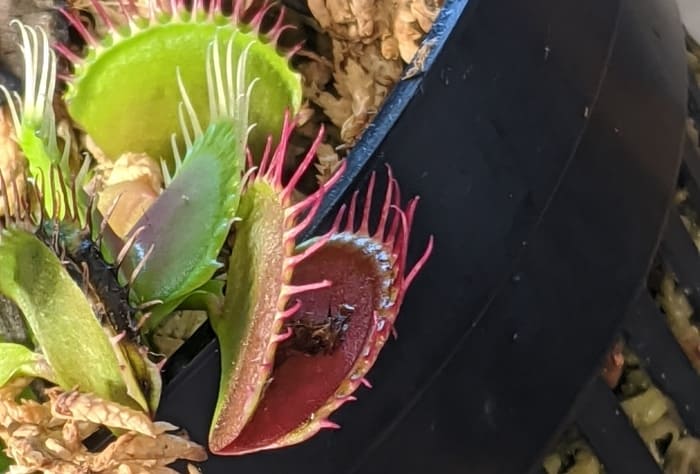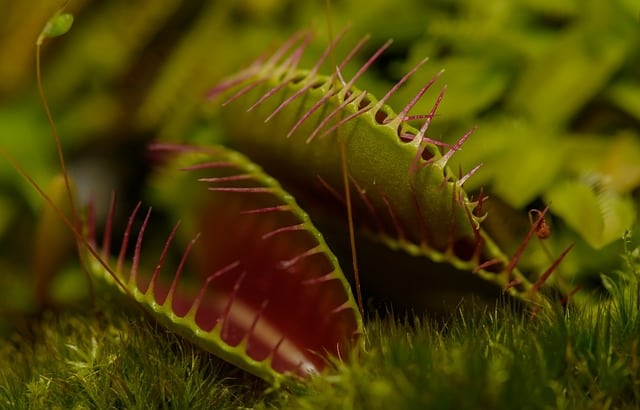Science fiction movies and media show Venus flytraps as large and dangerous creatures. However, after learning about Venus flytraps, I had no concerns about buying one and growing it as a house plant.
Venus flytraps can eat human flesh. In the wild, they can capture and consume meat from small reptiles or rodents. However, due to their small size, Venus flytraps can’t eat a human.
The Venus flytrap has developed successful trapping mechanisms and a taste for meat. In this article, you will learn about their meat-eating habits.
Can a Venus Flytrap Eat a Human?
Venus flytraps are small plants. They grow out of tiny seeds and take several years to reach maturity. Once they reach maturity, they start producing flowers. Af the time, the traps of the plant reach an average length of 1 inch.
1-inch traps are effective against a variety of insects. But, they are not big enough to capture larger prey. On rare occasions, Venus flytraps can capture tiny frogs or even birds, but those situations are unlikely.
Due to their size, a Venus flytrap is not big enough to capture a human. Still, the plant can consume flesh. Venus flytraps can digest small pieces of human or other animal’s flesh. It won’t process it completely, but it will absorb the soft part of the tissue.
Venus flytraps capture their prey and use enzymes to break up most of their victim. They will employ the same method to digest flesh or any meat. However, employing anything other than insects or spiders to feed a Venus flytrap is not recommended.

Venus flytraps are designed to capture and consume bugs. Even though they can consume meat, they are unable to digest large pieces of meat. Experimenting with unconventional meals can harm the plant. Venus flytraps lose leaves when they are unable to digest what they have captured.
Do Venus Flytraps Bite?
Venus flytraps can’t capture a human, but can they cause any other type of harm?
Venus flytraps are not dangerous to humans. They are not poisonous, and they do not bite. Venus flytraps are safe houseplants.
Venus flytraps have filaments on the edge of their traps that sometimes can look like teeth. The cilia are not pointy. You can touch it safely without injuring yourself. Actually, if you touch it, you will notice they are soft to the touch.
A Venus flytrap can close after been triggered by a human. The video below shows a quick demonstration of what you should expect.
Sticking your finger in a Venus flytrap is safe for humans. You can stick your pinky and wiggle it around. The trap will close, but the plant is not strong enough to keep you there. You will feel pressure, which is amazing, considering a plant is literary grabbing you, but totally inoffensive.
Technically, Venus flytraps do not bite. The leaves of the plant close due to stimuli. They close to capture potential prey. But they do not chew the insect. Instead, they trap it and digest it with enzymes.
You can leave your finger inside a Venus flytrap for a long time before observing any effects. These plants take several days and sometimes weeks to digest a tiny insect. The enzymes Venus flytraps employ are appropriate but very weak to break into human flesh.
Venus Flytrap vs Human: Endangered Status
Venus flytraps are sometimes portrayed as monsters. But, in reality, they are harmless to us. The only ones that should worry about their dangers are insects, which are their primary prey.
Even though humans are safe from Venus flytraps, Venus flytraps are not always safe from humans. Venus flytraps are an endangered species. They are protected, but unfortunately, their wild population continues to decrease.
Changes in the environment have significantly affected Venus flytraps. These plants are native to a particular area in the United States. They only grow naturally in South Carolina and North Carolina.
Their natural habitat has been affected by urbanization and the expansion of agricultural areas. Also, illegal poaching is affecting the preservation of this species.
Poaching occurs when people extract Venus flytraps from the wild to sell them or to own them. Due to the popularity of Venus flytraps, many opt for poaching Venus flytraps rather than growing them. Poaching has significantly affected the wellbeing of the species.
A vast number of Venus flytrap growers and nurseries responsibly grow these plants without ever harming their habitat or poaching plants. But, still, illegal poachers continue to extract Venus flytraps from the wild.
Besides their endangered status, Venus flytraps have a far higher chance of being hurt by humans than the other way around. It is a challenge to keep Venus flytraps alive at home. They require a particular setup with carnivorous plant soil, plenty of lighting, and pure water (among other things). Some novice growers lose their first plants due to inexperience. It is very easy to commit some basic mistakes and kill a Venus flytrap after just a few weeks.
If you are interested in growing Venus flytraps, make sure to do some extensive research beforehand. Or, you can read this article on Venus flytrap care. It covers all you need to know to keep Venus flytraps alive. Also, it includes a free care sheet you can download as a pdf.
What Would Happen if You Were Trapped in a Venus Flytrap
This section is a fun explanation of happens inside of the leaves of a Venus flytrap. If humans were small enough to fit in the traps or if Venus flytraps were huge, then we could be potential victims of a Venus flytrap.
Venus flytraps are plants. They do not have a brain; they respond to electrical stimuli. Each of the leaves of a Venus flytrap has a trap. The trap is made up of two lobes. Inside each of the lobes, there are three thin filaments arranged in a triangular pattern.
The lobes of a Venus flytrap close when something has come in contact with the trigger hairs twice within a few seconds. When the trap is triggered, it closes. At this stage, victims try to escape. A human could try to push the leaves apart or break the leaves. In the real world, some insects escape from Venus flytraps. Beetles are sometimes big enough to open up the traps. Slugs or caterpillars can attempt to eat their way out before it is too late.
There are two main ways to escape: breaking the leaf or opening up the lobes by force. The second one would be a more viable option for humans, as we do not have teeth made for chewing leaves.
After the victim is trapped inside the lobes, the plant waits for further stimuli to ensure it caught live prey. Staying immobile for a few minutes is enough to trick the plant into opening back up. But, unfortunately, for insects, most victims crawl around to try to escape and cause further stimuli.
When the plant receives further stimuli, it starts producing digestive juices. But, would it be a slow death?
Not really…
The plant produces enzymes which fill up the closed trap. The enzymes are weak; they do not dissolve the victim immediately. The prey ends up drowning. It would be a scary death to die inside a Venus flytrap, but it won’t be slow. The victim dies downing as the enzymes start causing major effects. The enzymes will take a few days or even weeks to digest the victim.
Since the enzymes are weak, the plant won’t digest a whole insect or a human. The high protein content in human meat would be hard to digest. Also, the bones would be left behind as leftovers.
In real life, the Venus flytrap is unable to consume most bugs completely. When the leaf opens back up, they leave the exoskeleton behind.
The picture below shows the remains of a mealworm I fed to my plant. The leftovers are not much. They are dried up.

If Venus flytraps were large creatures, they would be scary. Dying inside a Venus flytrap is definitely terrifying, but luckily, they are small plants. Maybe you would even consider owning one as a pet!


